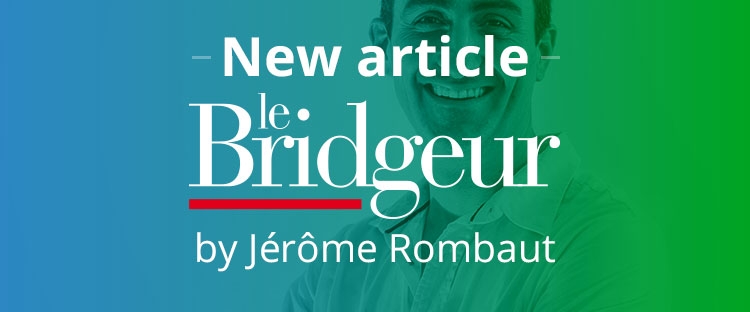
Artificial Intelligence (Le Bridgeur Magazine No.909)

Article written by Jérôme Rombaut and published in the french magazine Le Bridgeur No.909 (May/June 2017)
I am pretty sure that you have already practised opening leads and disagreed with your partner hundreds of times! Nowadays you can have leads tested by software programs analysing thousands of deals.
I am going to talk about leads in this column for a change. First of all, I would like to clarify one thing about leads on Funbridge. Sometimes I am told that Funbridge AI “Argine” leads differently depending on players. I would like to assure you that it never happens! Argine leads following strict rules that are the same for everyone. The only case in which Argine may lead differently is when the auction (or the meaning of the bids) at both tables is different. For instance, if a player decides to hide his four hearts in response to Stayman, Argine will necessarily tend to lead hearts.
Today’s lead problem has nothing to do with Argine but was raised during a discussion with Cédric Lorenzini. We were giving a course together and we could not agree about a lead despite that the sequence was very simple: 2NT-Pass-3NT.
We were wondering about the right lead with ![]() J765
J765 ![]() K765
K765 ![]() 765
765 ![]() 76. Cédric told me that with such a weak hand, the only chance of taking the contract off was to underlead the King-fourth to try to hit the jackpot in the opposite hand with a long heart suit and a complement in the suit. Roughly speaking, finding the Queen-fifth in spades will not necessarily result in the defeat of the contract, whereas the heart Queen-fifth will probably be enough (with an outside entry).
76. Cédric told me that with such a weak hand, the only chance of taking the contract off was to underlead the King-fourth to try to hit the jackpot in the opposite hand with a long heart suit and a complement in the suit. Roughly speaking, finding the Queen-fifth in spades will not necessarily result in the defeat of the contract, whereas the heart Queen-fifth will probably be enough (with an outside entry).
As for me, I was in favour of the standard principle also followed by Argine, i.e. underleading in the lower-ranking 4-card suit.
To decide the winner (educate ourselves and entertain you as well), I asked Pierre Schmidt (Chat’s designer) and Alexis Maugat (Argine’s designer) to run their “babies” and see what they say.
Here are the test conditions: Chat and Argine play double dummy, therefore they are always faced with the best possible declarer’s play of the hand and defence. Of course, it remains relevant in order to compare leads since these two advantages balance each other out. The analysis of thousands of deals has shown that declarer takes 10.2 tricks on average and fails to make his contract in only 7% of cases.
Chat indicates that the best lead is diamonds (in 70% of cases), then spades (67% of cases) and hearts (60% of cases). It adds up to more than 100% because several leads are often equivalent in terms of results. In terms of play of the hand, it does not see much difference between the three leads.
For its part, Argine analysed the deal in a teams match. Out of 5,000 deals analysed, the spade lead came out first 1,454 times vs. 1,016 times for the heart lead. They were equivalent in 2,530 cases.
The IMP difference was +1741 IMP for the spade lead and +1016 IMP for the heart one.
In conclusion, these small artificial intelligence systems found that the spade lead seems to be better than the heart one. I will thus just continue to follow my basic principles: leading fourth best from my longest suit and with two 4-card suits, leading the lower-ranking one.



